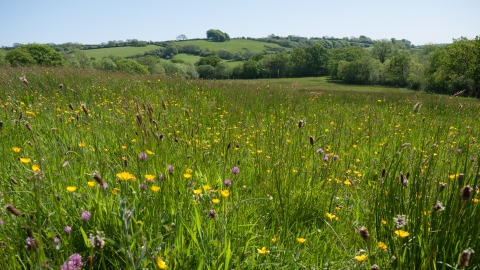
Matthew Roberts

Grassland
How grassland is classified
Grassland is generally divided into upland, which is above 300m and lowland. This is because the cooler, wetter climate of upland areas favours different species to the warmer, drier and less exposed lowlands. Both types may also be classified as:
- Calcareous - found on shallow lime-rich soils
- Acidic - found on sands, gravels and siliceous rocks
- Neutral - found on clay and loam soils
Meadows are enclosed grasslands where a hay or silage crop is taken in the summer, while pasture is generally grazed.
A natural solution to the climate crisis
UK grasslands store two billion tonnes of carbon in their soils, but this is vulnerable to disturbance. Between 1990-2006, conversion from grassland to arable production (such as ploughing to grow crops) released 14 million tonnes of CO2. Species-rich grasslands are huge carbon stores and when managed carefully they lock in carbon and boost biodiversity.
Grasslands have a huge potential for locking up carbon, not only due to the plants we can see on the surface, but also due to the relationships between the plants, fungi, bacteria and many other species which help enrich the soil with carbon.
Ancient origins
Grassland is an ancient habitat. Following the last Ice Age around 12,000 years ago, mossy vegetation and weedy plants colonised bare ground. This was left after the glaciers that covered the UK had melted. Gradually they developed into communities of grasses, sedges and herbs as more plants found a home. As birches and other tree species arrived and spread, these grassland habitats were pushed back to exposed sites on the coast or high in the mountains.
Grasslands also existed in areas where trees were lost over time such as on floodplains or woodland clearings grazed by wild animals. However, it wasn’t until human activities intensified around 6,000 years ago that grassland began to expand. Today around 40% of the UK’s land surface is grassland.

Grassland - Emma Bradshaw
Precarious future
Most of today’s grassland is farmland or rough upland grazing, with only a tiny proportion of ‘unimproved’ grassland remaining. This is grassland that hasn’t been reseeded, fertilised or drained and tends to be full of flowers and wildlife. In England there are around 4.5 million hectares of grassland, of which just 100,000ha are unimproved.
Degradation began as fertilisers started to be used. During the 1940s and 1950s chemical fertilisers, herbicides and new grass varieties were used to increase yields. At the same time government incentives encouraged farmers to plough up grasslands. During the 20th Century, 90% of lowland grasslands were lost.In the uplands, the story was different, but the decline in grassland was just as dramatic. Here, overgrazing led to moorland and blanket bog being converted to less wildlife-rich upland acid grassland and rush pasture.
Unimproved, species-rich grassland is still being lost and grassland on protected sites is deteriorating. The numbers of butterflies and breeding birds, such as curlew and lapwing, continuing to decline. Unimproved grassland supports many rare and beautiful species. This includes orchids, snake’s-head fritillary, waxcap fungi and blue butterflies.
Historically, grasslands have been used in many different ways. The traditions and skills associated with water meadows, shepherding and haymaking are part of our cultural heritage.

Jon Hawkins - Surrey Hills Photography
What we are doing
We are working to ensure that precious grassland habitats and traditional management techniques are not lost. Careful grazing with traditional breeds and hay-cutting at the right time are some of the ways our fragile grassland habitats are kept in good condition. We are also working closely with farmers and landowners to promote wildlife-friendly practices for managing grassland habitats.









